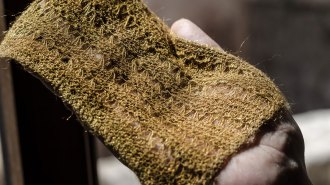Invent by Number: Researchers predict, then produce superior titanium alloys
- More than 2 years ago
Ingenious people have produced alloys since ancient times. By trial and error, they mixed metals and other elements until the whole came out better than any component alone. In recent years, some scientists have said that alloy development is a mature field with little room for improvement.


This week, however, researchers report a new method for making titanium-based alloys with many qualities far superior to those in any alloy previously known.
The team originally intended to develop materials for automobile parts, says Takashi Saito of Toyota Central Research and Development Laboratories in Nagakute, Japan. Instead, he and his coworkers wound up with materials that Saito says are too expensive for mass production in automobiles but have unusual properties suitable for a new generation of precision screws, eyeglass frames, medical devices, sporting goods, and spacecraft parts.
The alloys are strong yet unusually elastic, so they can deform more than other alloys and still return to their original shape. Engineers can also readily mold or bend the materials at room temperature into various shapes, a property called superplasticity.
The materials also possess two characteristics desirable in machine parts that experience wild fluctuations in temperature, such as those in a spacecraft. While most metals expand with any rise in temperature, the new alloys expand very little between –200C and 300C. Moreover, conventional alloys deform different amounts at different temperatures, but the new materials show about the same deformation whether it’s –200C or 300C.
Saito and his coworkers report in the April 18 Science that they devised calculations with which they can predict what combination of elements would make an alloy with these properties. The researchers determined that a desirable titanium-based alloy must meet three criteria, which they call “magic numbers,” that are based on quantum mechanical calculations reflecting the behavior and arrangement of atoms and electrons.
The scientists add that an alloy meeting the criteria must be cold worked, or deformed by compression at room temperature, before it shows the extraordinary properties.
So far, Saito and his colleagues have made several titanium-based alloys that fit these criteria and possess the desired properties. The materials all include oxygen, and one, for example, also contains niobium, tantalum, and zirconium.
The new alloys’ properties are “remarkable,” says Gary Shiflet of the University of Virginia in Charlottesville. In particular, he says, their superplasticity could eliminate the need for expensive machining techniques when shaping titanium alloys into products.
Perhaps more importantly, says Shiflet, the new report demonstrates the power of a computational method to predict alloys that never would have been made through trial and error.
Now, Shiflet asks whether the magic-numbers approach applies to other important classes of alloys, such as the nickel-based ones. “We will try it soon,” says Saito.
****************
If you have a comment on this article that you would like considered for publication in Science News, send it to editors@sciencenews.org. Please include your name and location.
To subscribe to Science News (print), go to https://www.kable.com/pub/scnw/
subServices.asp.
To sign up for the free weekly e-LETTER from Science News, go to http://www.sciencenews.org/subscribe_form.asp.







